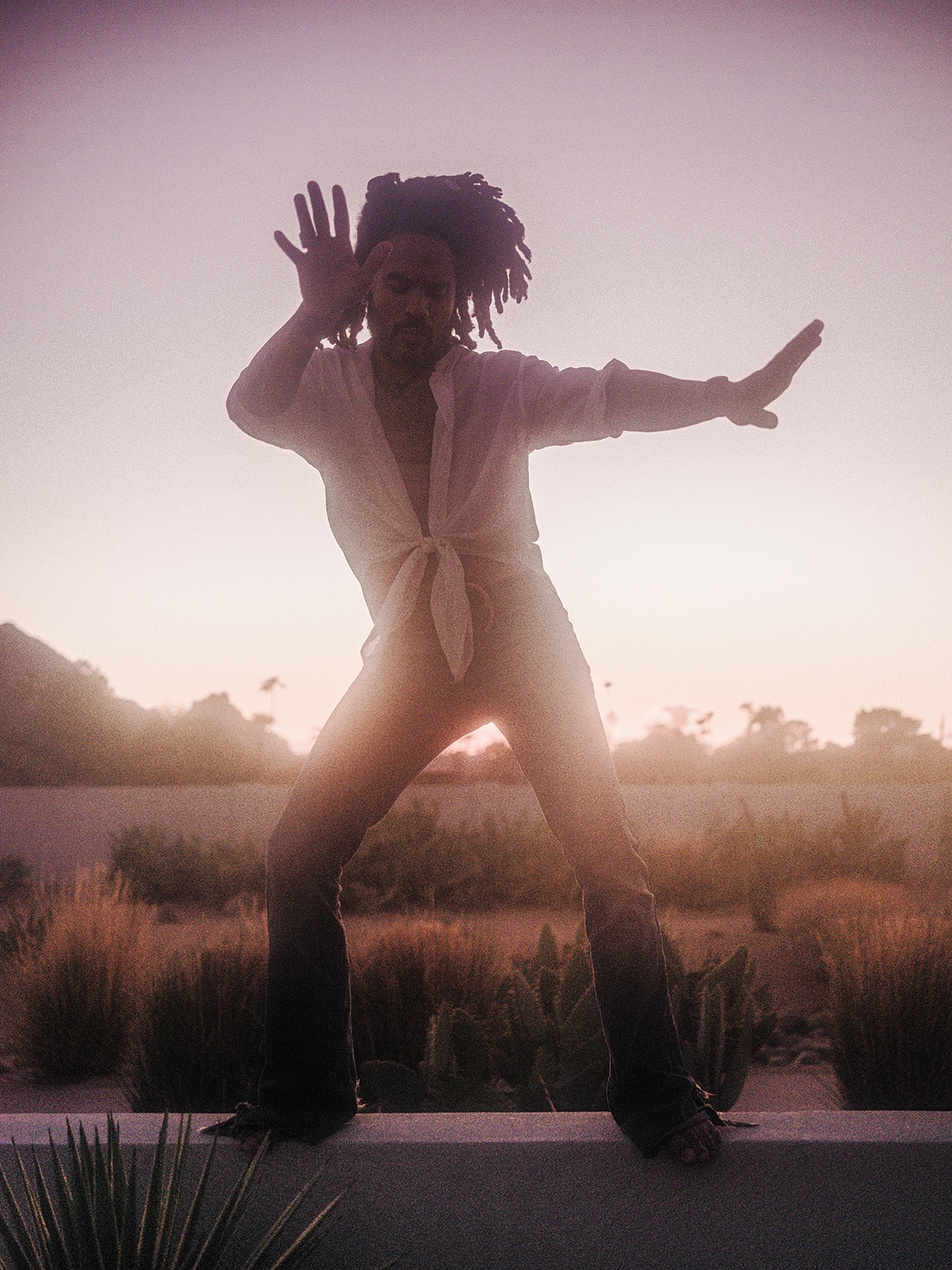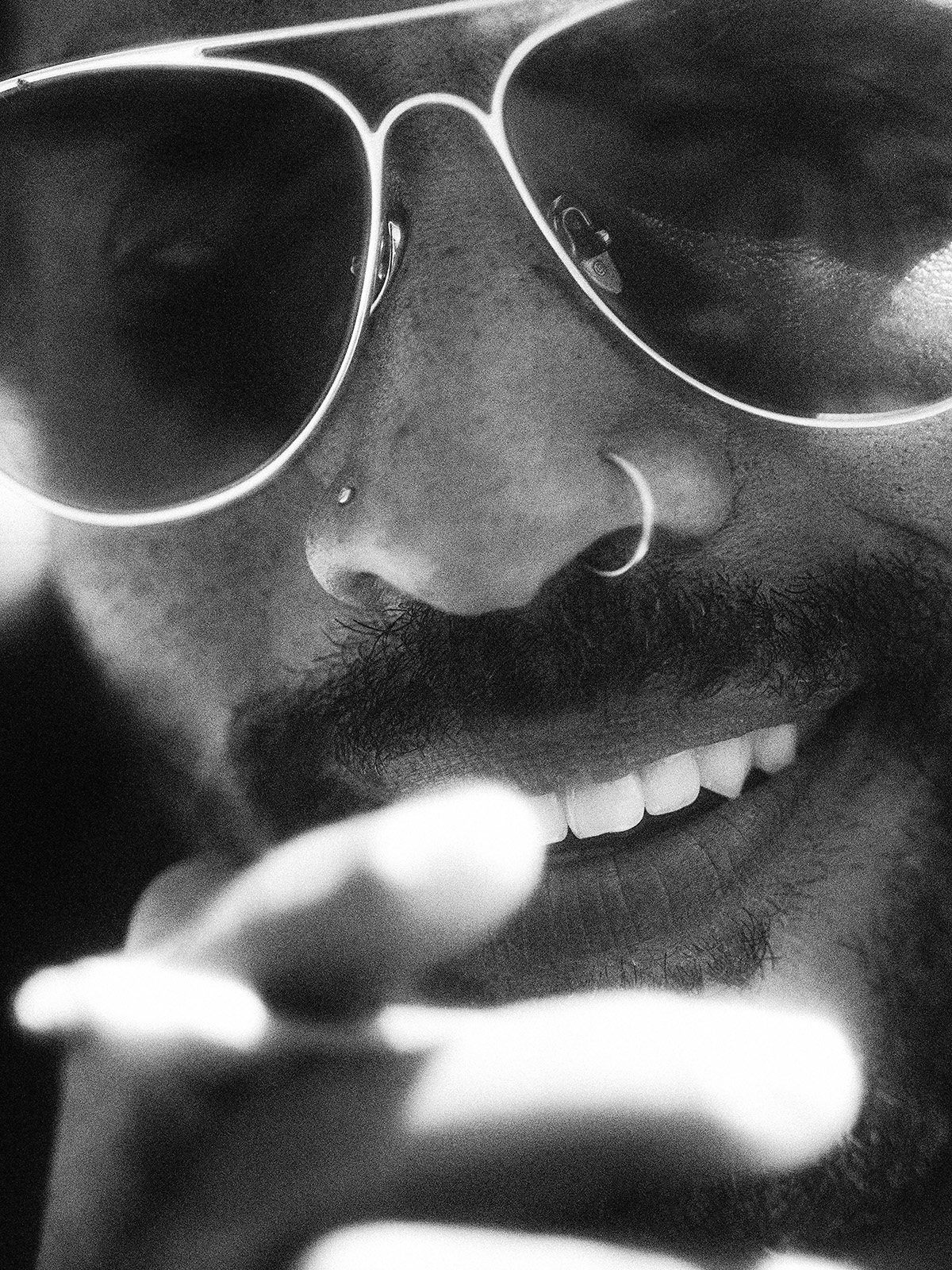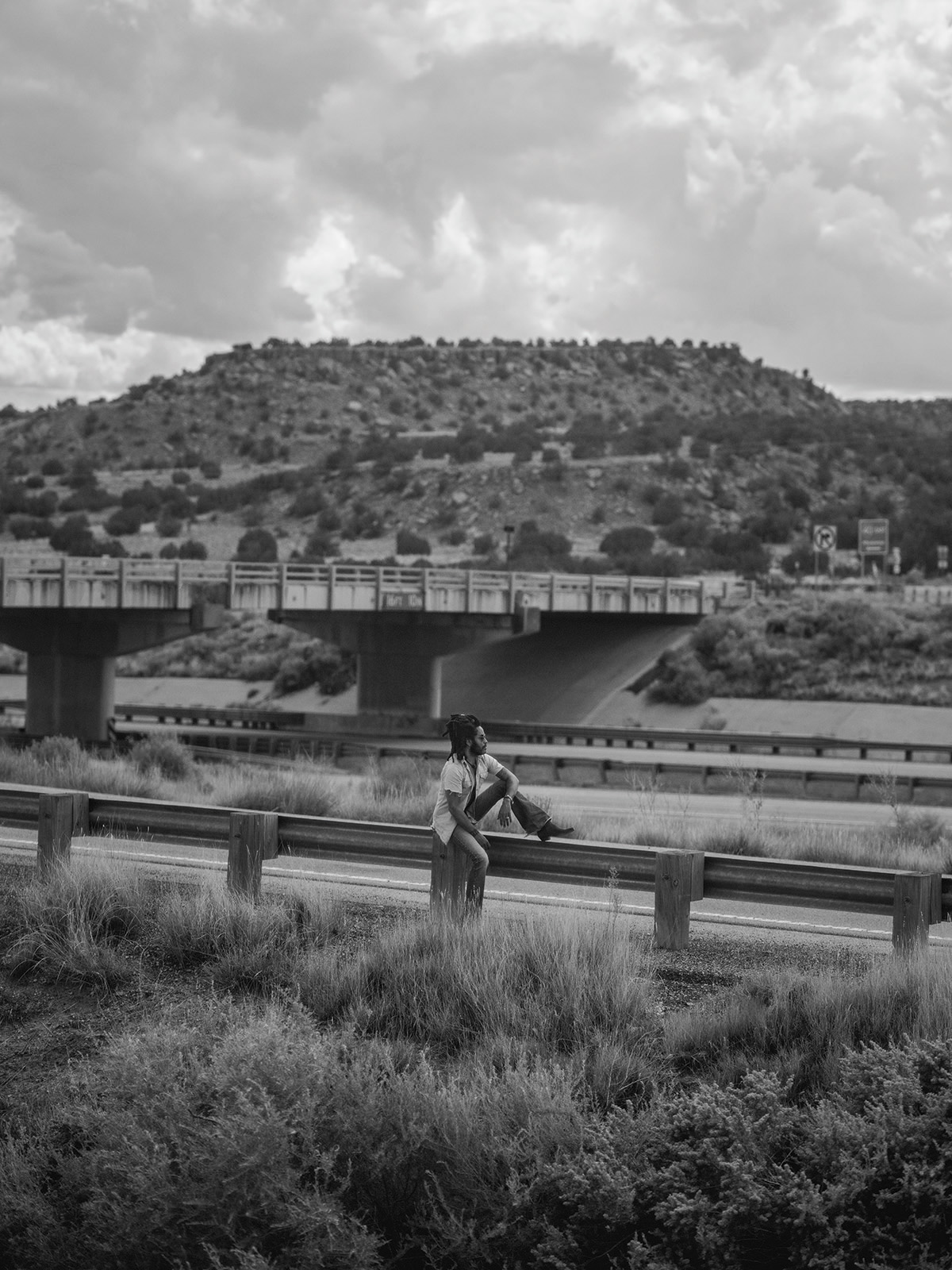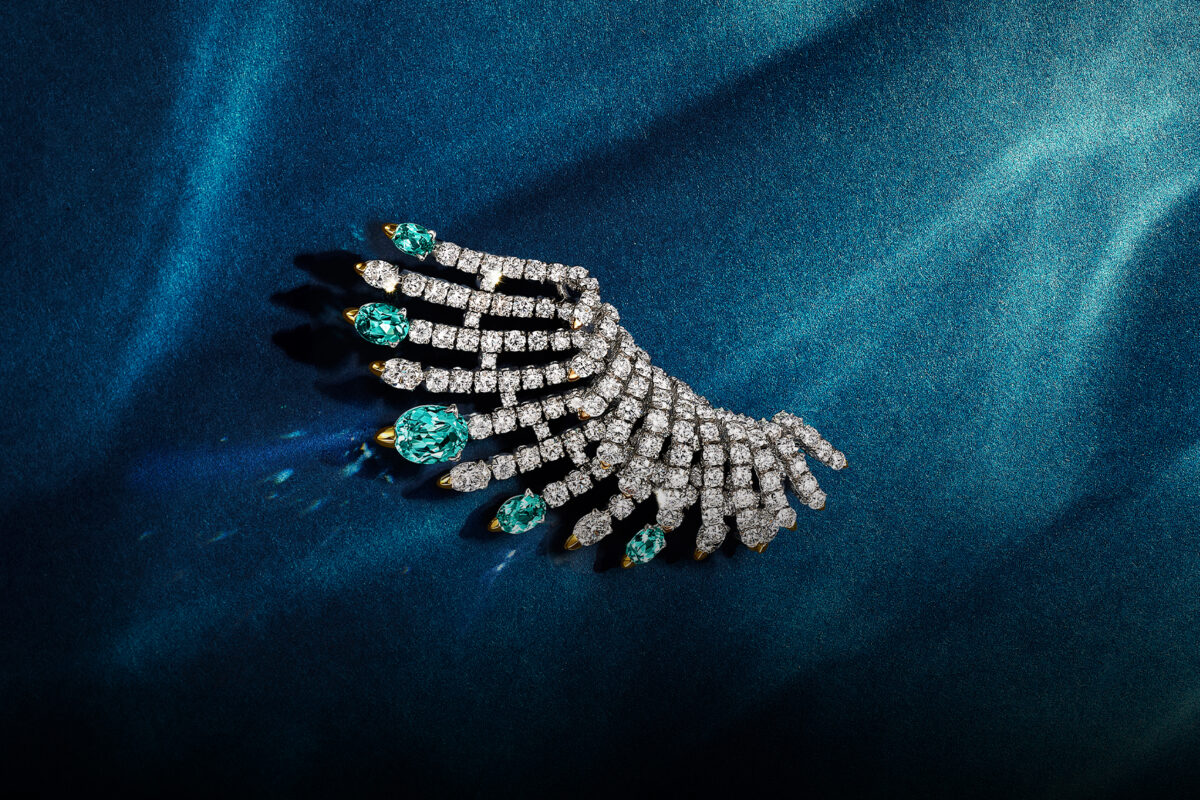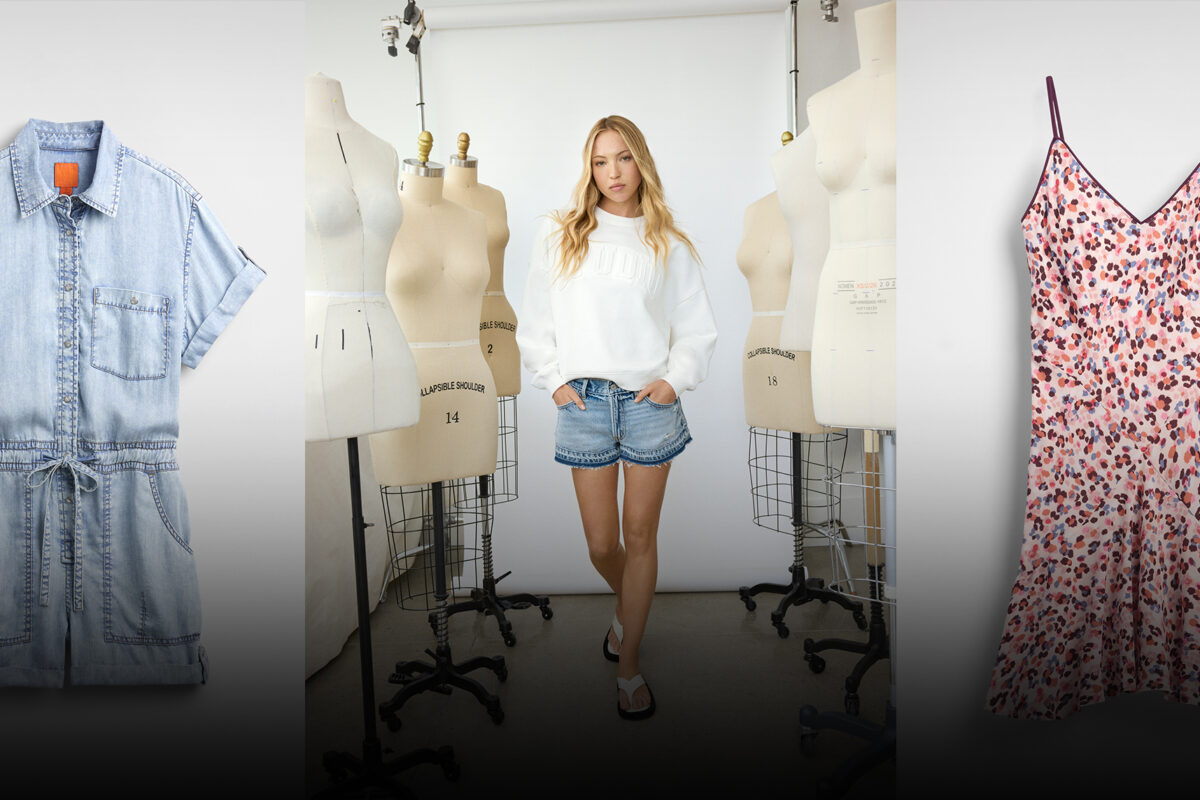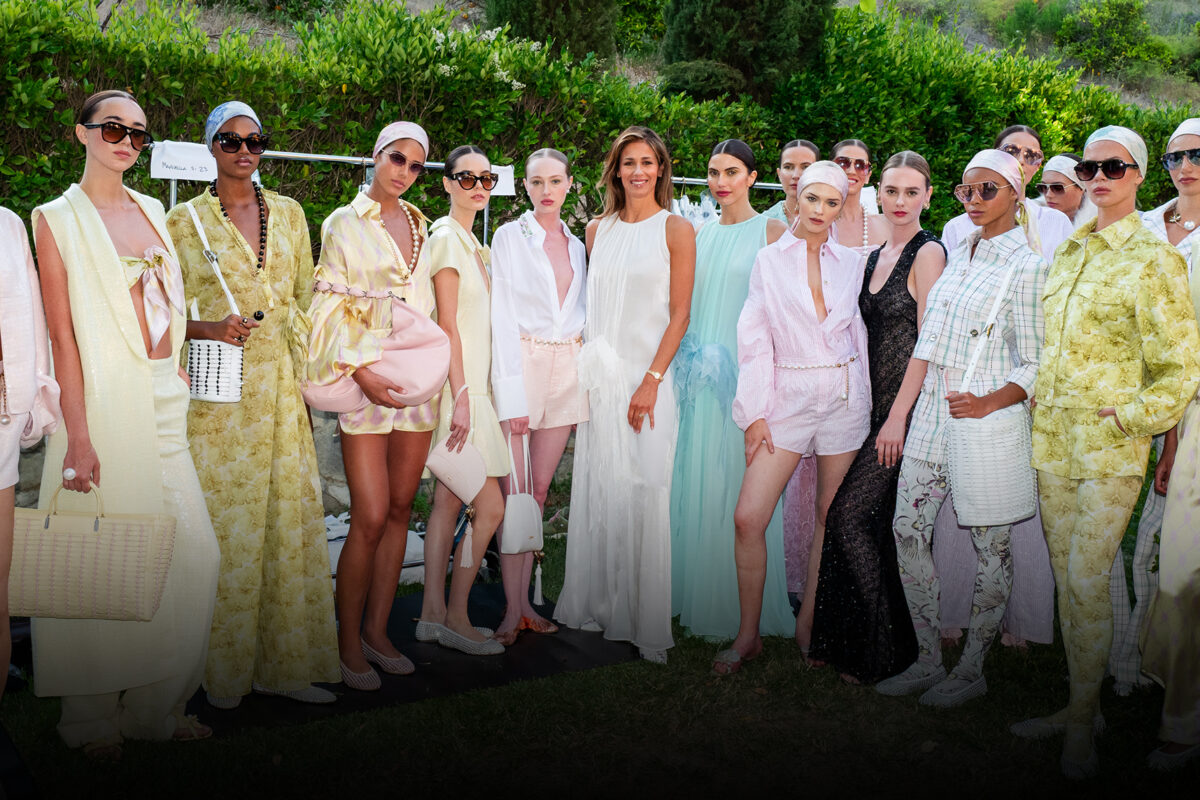From his self-isolation in the Bahamas, the renaissance-man rock-god and sometime Californian talks hope in a time of global turmoil
Words by STEPHANIE RAFANELLI
Photography by NADINE KOUPAEI
It’s 79 degrees on the Bahamian isle of Eleuthera. The sun is strong and high over 100 miles of coastline; today, no footprints in the sand. Only birdsong and breeze inhabit pineapple plantations. In his island uniform of jeans, shades and dreads, Lenny Kravitz sits outside his Airstream: He lives here while recording at his studio, Gregory Town Sound, playing all the instruments on every track, periodically washing his clothes with Dr. Bronner’s almond soap and a hose, leaving them to dry on the rocks.
LENNY KRAVITZ wears a SAINT LAURENT BY ANTHONY VACCARELLO shirt, $1,890. CHROME HEARTS custom pants. Vintage belt and jewelry.
“I end up spending weeks alone in nature: I think, I make music, I sleep. I get sort of lost in that world,” he tells me, his voice as rich and grounded as Bahamian soil. “I’m at my most peaceful here.” Only a few islanders meet this monastic version of Lenny, the gentle hermit and spiritual man with a musical manifesto of peace and love, who is vegan and exists off the land; who seems so at odds with public Lenny, the raw performer, nostalgic collector and interior designer, the spectacular peacock with a wanton bare chest, otherwise clad in textural fabrics. Three working decades, 40 million album sales and four Grammys down, with zero visible signs of his 55 years, he is still considered the apotheosis of worldly rock star.
Vintage sunglasses.
“This could be a beginning of a new way of life, where we are all one human race”
Lenny Kravitz
I’m not, this time, there to share in this glorious day, for both Kravitz and I, like the majority of the globe, are now in lockdown at our respective homes: He has just canceled the Australasian leg of his world tour — this being the third year on the road for his 11th studio album, Raise Vibration. But he isn’t phased by the solitary existence that faces us all. “The way I normally live here is similar to a quarantined life,” he tells me on the phone. “I always see this time as a blessing: a time to disconnect from the system, from other people; to listen, to hear and work on yourself; come closer to God.” This is a rare occasion that is now to extended to us all. “People are so used to popping in and popping out [of their lives], coming and going. There are so many ways for us to escape ourselves and sort of disappear. … [Right now] you hear people talk about what they’re learning about their lives, about themselves, their partners, their children. It’s very interesting, this ‘sit back and reset’ that’s going on.”
Vintage YSL jeans. Vintage scarf, belt and jewelry.
Kravitz has been singing about positive human change for the last 30 years. I first interviewed him at his other home in Paris in 2017, finding his bohemian outlook to be underpinned by his maternal grandfather’s old-school Bahamian values of “discipline” and “respect.” But there is another image of him that always sticks in my mind: A photograph of him as a young boy, at a school fair in the early ’70s on the corner of Manhattan’s East 81st Street and Madison Avenue. Reproduced on the cover of his 2011 album, Black and White America — a celebration of Obama-era multiculturalism — the photograph shows Kravitz with a peace sign on his forehead and the word “love” on his right wrist, painted by his mother, actor Roxie Roker. Then a member of the Negro Ensemble Company, Roker was also a civil rights activist and friend of Maya Angelou, Nina Simone and Miles Davis. Kravitz laughs now and says: “That was my statement!” And it has been, ever since his debut album, Let Love Rule (1989), and follow-up, Mama Said (1991). On the cover of the latter, he appeared in his mother’s feather boa and his Jewish father’s flared suit as the living resurrection of late ’60s rock-and-raunch godliness and the Summer of Love.
“If my Airstream was all I had, I would still be living like a king”
Lenny Kravitz
Though he has evolved through many incarnations, Kravitz’s key message has remained consistent right up to Raise Vibration, an urgent call for compassion in the face of white supremacy, corruption and climate change, that came to him in the Bahamas in a series of dreams. For the track “Here to Love,” he directed a video with the United Nations Human Rights Office for its #FightRacism campaign. He says his late mother would be “appalled” by today’s social and political climate, but he sees hope of a new era of oneness in the global pandemic. “We have seen how what affects one person on the other side of the world directly affects us all,” he says, low and slow. “This could be the beginning of a new way of life, in which we treat each other with respect and realize that, no matter how different we may be from each other, we are all one human race.”
Vintage YSL shirt, jeans and boots. Vintage sunglasses and jewelry.
In recent years, Kravitz has experienced his own relative set of priority shifts. He has owned properties all over, from New York, Miami and New Orleans to Brazil, the Bahamas and Paris. (His daughter, Big Little Lies actor Zoë Kravitz, now 31, recalled for Rolling Stone in 2018 how her dad would pick her up from school in a sports car and leather trousers after she moved to Miami at age 11 to live with him.) On the suggestion of Philippe Starck, he founded his own interiors company, Kravitz Design, in 2003. “There’s nothing wrong with luxurious things as long as, at the end of the day, you can just walk away. It’s been an exercise for me in the last year or two to shed as much as possible. It’s a process. If I just had this Airstream, I would still be living like a king as far as I’m concerned. I don’t lack for anything here.”
He still has his moments of being a Champagne hippie. In his other life, he is the creative director of Dom Pérignon, and he recently designed a vegan snakeskin camera for Leica. He still owns his organic farm outside Rio de Janeiro and a stately mansion in the 16th arrondissement of Paris with a basement speakeasy befitting his rock persona, adorned with a Basquiat and vintage pieces by Pucci and Gabriella Crespi. Most of his collected objects have sentimental significance — the heeled boots of his late friend Prince and items that once belonged to his heroes James Brown and Muhammad Ali.
“It’s very interesting, this ‘sit back and reset’ that’s going on”
Lenny Kravitz
It’s all a million miles from monastic Lenny, for whom the trusty Airstream has further honed design skills. “I think it teaches me how little space you can live in.” He says it feels “womb-like,” a term he also uses for the lobby of 75 Kenmare, the New York apartment block he recently completed. He has always seen homes as places to nurture, as cocoons. “Your home is your refuge, regardless of size. It’s about the vibe. You can walk into somebody’s studio apartment that feels worth more to your senses than a 24,000-square-foot home.” And he hasn’t lost his magpie’s eye, often turning to his old stomping ground of L.A. for finds: his latest snatch is a rocking lounger by Oscar Niemeyer, who is among his favorite designers, along with Chemosphere architect John Lautner.
Vintage sunglasses. RED RABBIT TRADING CO. ring.
He’s an aficionado of midcentury Californian design. His company has worked on several iconic L.A. homes, including one in the Trousdale Estates by Jack Charney, which has been described by Architectural Digest as “Slim Aarons meets Casino.” Alongside the interiors of the Temple Hotel in Detroit, Kravitz Design is currently working on two more midcentury homes in Malibu. The design period is nostalgic for Kravitz: In 1974, when his mother was cast in The Jeffersons, she was one-half of America’s first television portrayal of an interracial marriage (it mirrored her own, with news producer Sy Kravitz), the family decamped from Manhattan to Baldwin Hills.
“It was this beautiful midcentury-modern house, with glass in the back, overlooking Los Angeles. To me [aged 10], it was like what you saw in the movies,” Kravitz says. The same was true of his mother’s friends’ homes: “Ray Charles lived in a midcentury house in the area,” he recalls. But there are also sad memories: He was at producer Rick Rubin’s house in 1995 on the day his mother died of cancer, where Johnny Cash comforted him. It was Roker who taught him of the immateriality of the material. “‘I have to look at myself in the mirror every day,’” he says she used to tell him. “‘And who I am is the person without any of those things.’”
By then Kravitz had married and divorced Cosby Show star Lisa Bonet (Zoë’s mother), with whom he lived in Venice in two adjoined craftsman houses before they split. Kravitz is still close with Bonet and her husband, Jason Momoa, who live in Topanga Canyon with their two children. Kravitz tells me, “We are one family, wherever we are dispersed.”
Vintage YSL shirt and jeans. Vintage sunglasses, belt and jewelry.
Bonet and Momoa’s entire brood descended on the Paris residence of Kravitz, who is currently single, last June for Zoë’s wedding to actor Karl Glusman. “It was one of the most beautiful things I have ever witnessed. It was about love. It inspired people to want to love more, harder, stronger, deeper.”
He is concerned right now about Zoë, who is stranded in London, where she’s been filming her role as Catwoman opposite Robert Pattinson in The Batman (scheduled to be released next year). “Of course, I’m concerned for the safety of my child, but I trust her instincts, and she’s with her husband,” he says. Kravitz has also been checking in with friends, including his “big brother” Denzel Washington. “Denzel is good, everybody is good,” he says. “The beautiful thing is that everybody’s together, under one roof. I’ve called a lot of people that I haven’t spoken to in years; maybe we had some issues, but you realize now that’s not important.”
The most uplifting thing to come out of near-planetary shutdown, he says, is the state of the planet. “Ships aren’t going back and forth, there are less planes, less cars. … We are hearing about animals and sea life showing up in places that they haven’t been for years. The planet is beginning to heal itself,” he says over the sound of Eleutheran wind, now picking up in the palm trees. “I just hope that at the end of all of this we can say: ‘How do we go forward in our lives so that we can continue to heal the planet?’ I just wish that we could do that.”
ON THE COVER: KRAVITZ wears vintage sunglasses.
Feature image: GARÇONS INFIDÈLES shirt, vintage YSL jeans and vintage jewelry.
This story originally appeared in the Spring/Summer 2020 Men’s Edition of C Magazine.
Discover more STYLE news.

